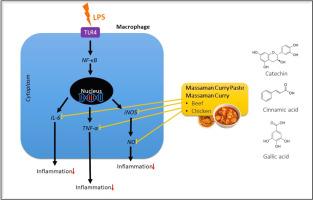Assessment of inhibitory effects on inflammatory mediator production in lipopolysaccharide-stimulated RAW 264.7 murine macrophage cell line: An in vitro study of beef and chicken curry incorporating massaman curry paste
引用次数: 0
Abstract
The inflammatory response is the most prevalent and significant complication associated with numerous non-communicable diseases (NCDs). Therefore, there is growing interest in using curry paste as a functional ingredient containing numerous bioactive compounds, incorporated into meat-based chicken and beef curry, to develop functional foods that reduce inflammatory activity and cytokine production. This study aims to investigate the anti-inflammatory properties of aqueous extracts from massaman curry paste (MCP), which was further incorporated into chicken massaman curry (CMC) and beef massaman curry (BMC). The evaluation included total phenolic content (TPC), quantification of bioactive compounds and anti-inflammatory activity, including cytokines inhibition in lipopolysaccharide (LPS)-stimulated RAW264.7 murine macrophage cells. MCP exhibited the highest TPC (0.488±0.003 mg GAE/100 g extract) and contained various phenolic compounds such as catechin, cinnamic acid, ferulic acid, and coumaric acid. All aqueous extracts (MCP, CMC, BMC) were non-toxic to RAW264.7 cells (0.001–1 mg/mL). Their IC50 values for NO production ranged from 93.83 to 924.74 µg/mL, with significant reductions in TNF-α and IL-6 observed at 0.1 and 0.01 µg/mL, respectively. CMC demonstrated the highest inhibitory effect on NO production (IC50 value of 93.83 ± 0.87 µg/mL). Compared to BMC, CMC also showed greater suppression of TNF-α and IL-6 levels. This present study will be further extended to evaluate the efficacy of MCP and MCP-incorporated CMC and BMC curries in vivo and clinical applications to validate these findings in digestive system-associated diseases caused by inflammation.

脂多糖刺激的RAW 264.7小鼠巨噬细胞对炎症介质产生抑制作用的评估:含有马萨曼咖喱酱的牛肉和鸡肉咖喱的体外研究
炎症反应是与许多非传染性疾病相关的最普遍和最重要的并发症。因此,人们越来越有兴趣将咖喱酱作为一种含有大量生物活性化合物的功能性成分,加入到以肉为基础的鸡肉和牛肉咖喱中,以开发减少炎症活性和细胞因子产生的功能性食品。本研究旨在研究马萨曼咖喱酱(MCP)水提物的抗炎作用,并进一步将其掺入鸡肉马萨曼咖喱(CMC)和牛肉马萨曼咖喱(BMC)中。评估包括总酚含量(TPC)、生物活性化合物的定量和抗炎活性,包括对脂多糖(LPS)刺激的RAW264.7小鼠巨噬细胞的细胞因子抑制作用。MCP的TPC最高(0.488±0.003 mg GAE/100 g提取物),含有多种酚类化合物,如儿茶素、肉桂酸、阿魏酸和香豆酸。所有水提物(MCP、CMC、BMC)对RAW264.7细胞均无毒(0.001-1 mg/mL)。它们对NO生成的IC50值范围为93.83至924.74µg/mL,分别在0.1和0.01µg/mL时观察到TNF-α和IL-6的显著降低。CMC对NO产生的抑制作用最高(IC50值为93.83±0.87µg/mL)。与BMC相比,CMC对TNF-α和IL-6的抑制作用更大。本研究将进一步扩展以评估MCP和MCP结合的CMC和BMC咖喱在体内和临床应用中的功效,以验证这些发现在炎症引起的消化系统相关疾病中的作用。
本文章由计算机程序翻译,如有差异,请以英文原文为准。
求助全文
约1分钟内获得全文
求助全文
来源期刊

Food chemistry advances
Analytical Chemistry, Organic Chemistry, Chemistry (General), Molecular Biology
CiteScore
1.90
自引率
0.00%
发文量
0
审稿时长
99 days
 求助内容:
求助内容: 应助结果提醒方式:
应助结果提醒方式:


